After a tiny bit of dabbling in natural dyeing last year, I seem to be taking a more serious plunge in that direction now! I have plans to grow some dedicated dye plants in my garden, and have been harvesting a few things from outdoors to dye with, too. But today I worked on some natural dyes from my kitchen, and I'm very excited about the results!
There had been a few threads on Ravelry about dyeing with kitchen spices and other common ingredients, so I decided to play with several. I was not at all scientific about my process, but I'll describe it as best I can. First, I combined the spices (in most cases, 1-2 Tablespoons of the spice) with hot water in glass jars, which I let sit for a few days. Then I strained out the solids and placed the liquids back in the jars, to which I added mordanted yarn (3 mini skeins per jar):

Oh right, mordanting! Last year when I played I used "substantive dyes" that didn't require any kind of mordant. Some of the kitchen spices may fall into this category, but I decided to try them all with mordants this time. I have plans to get larger quantities of mordants from a dyeing supplier, but for today I started with a simple alum mordant, using pickling alum (spice aisle of the grocery store) and cream of tartar. Combined this with water and heated it in a crockpot with all the sample skeins of yarn. Thus, mordanted yarn!
I let the skeins sit in the jars overnight. Some of them appeared to have really taken up a lot of colour, but others hadn't, so I decided I might need to apply some more heat this morning. For each jar, the process I followed was:
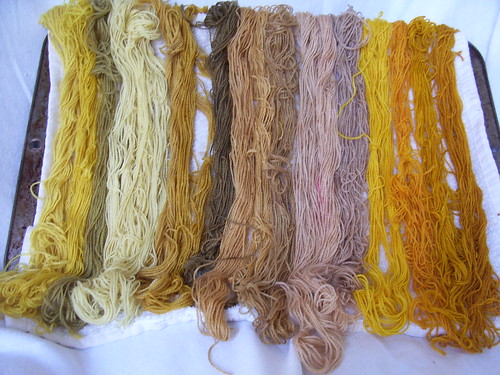
Lots of different yellows and browns, plus some greens and oranges. Pretty much the range I was expecting, but there were some delightful surprises. Reds, blues, etc. are pretty much unheard of from most kitchen ingredients, as I understand it (except black beans, which I assure you I will be trying soon!). They're hard to get from most plants, actually, but there are ways to do it.
Here are some more details about the colours I achieved today (in each case, the left skein is the plain alum, the middle is the ammonia, and the right is iron):

Fennel seed! This one excited me a lot, because I hadn't read much about fennel seed, so I didn't expect much. But check out the soft yellow, the gold, and the sage green. Nice, right?

Fresh sage. I had seen some pics on Ravelry of a lovely green obtained from dried sage, which I didn't have, but I had some leftover fresh after cooking, so I decided to go for it. The results are not exciting. That may be because the small amount of fresh I had just wasn't enough. At our last house I had a huge sage plant, and I never knew what to do with that much sage, it grew SO fast. I think I'll plant sage again, knowing that I have something I can try with large quantities of it!
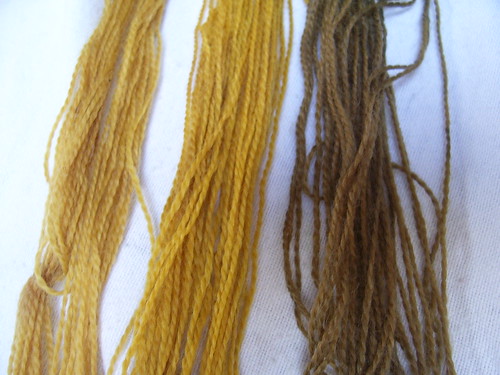
Dried whole cloves. Interestingly, there was a thread about this on Ravelry, too, but the results posted there by the 1 person who tried it were disappointing, so I wasn't expecting much. Imagine my delight! Straw, gold, and olive!
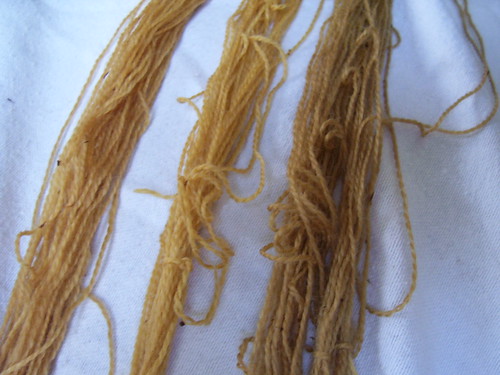
Black tea (orange pekoe, nothing fancy--from tea bags). I had used tea before as a substantive dye, but wanted to try it with mordants. Still just browns, but you can see that the different rinses/mordants did impact the colour a bit. And I do think they're awfully pretty browns.
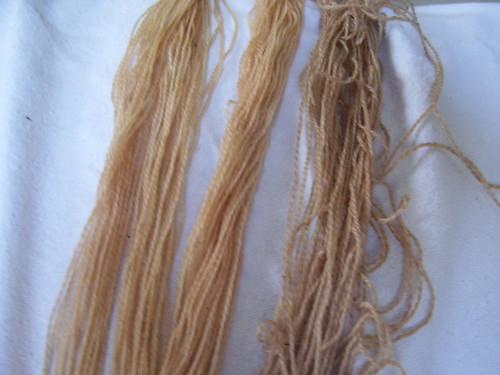
Black walnuts. Again, a repeat of an experiment from the fall. I think I boiled the nuts more in the fall, this colour isn't as strong. Maybe also because the nuts have been sitting for several months, though. Traditionally, dyers use the hull of the nut fresh off the tree. I don't have a tree, I just have the nuts (in shells), so I used those.
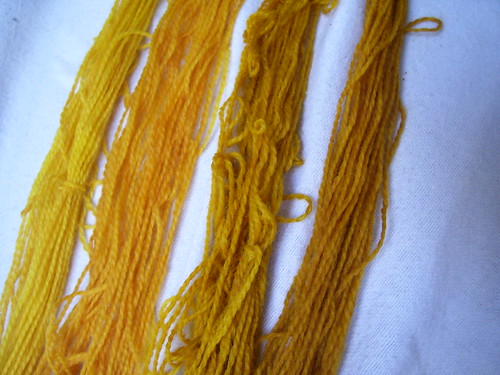
I think this is my favourite, although it's a tough call. (oh, and somehow there were 4 skeins in this jar--so I decided to do the 4th one in iron, with an ammonia rinse.) Turmeric! The reaction of the ammonia here just fascinates me. When I dropped the skein into the ammonia solution, it turned BRIGHT orange. When I rinsed it, that faded to the lighter orange you see here. Since taking the picture, I dropped the skein back in the dye stock, and then added some more ammonia--the change is instant the moment the ammonia hits, a pretty bright red-orange. Again, it rinsed mostly off although not quite as much. I soaked it a third time in ammonia (again, instant change!). This time I just squeezed it out and set it to dry. I'll try rinsing it after it's dry & see if that makes any difference, because I LOVE the colour the ammonia gives it. I'm also just enthralled to watch the reaction between the ammonia & turmeric, I think I could repeat that process all day and not get bored with the colour change, LOL!
So I have plans for lots more natural dyeing, but am super excited about today's results. If my shipment of undyed yarn ever shows up (getting frustrated with 1 supplier, and in the other case with Canada Customs, I think!), I plan to do some naturally dyed skeins for sale at the Knitter's Frolic in Toronto next month!!
There had been a few threads on Ravelry about dyeing with kitchen spices and other common ingredients, so I decided to play with several. I was not at all scientific about my process, but I'll describe it as best I can. First, I combined the spices (in most cases, 1-2 Tablespoons of the spice) with hot water in glass jars, which I let sit for a few days. Then I strained out the solids and placed the liquids back in the jars, to which I added mordanted yarn (3 mini skeins per jar):

Oh right, mordanting! Last year when I played I used "substantive dyes" that didn't require any kind of mordant. Some of the kitchen spices may fall into this category, but I decided to try them all with mordants this time. I have plans to get larger quantities of mordants from a dyeing supplier, but for today I started with a simple alum mordant, using pickling alum (spice aisle of the grocery store) and cream of tartar. Combined this with water and heated it in a crockpot with all the sample skeins of yarn. Thus, mordanted yarn!
I let the skeins sit in the jars overnight. Some of them appeared to have really taken up a lot of colour, but others hadn't, so I decided I might need to apply some more heat this morning. For each jar, the process I followed was:
- dump the liquid & yarn into small saucepan (an old one I don't use for food anymore), bring it to a simmer. Maintain the simmer for just a few minutes.
- Remove 1 mini skein and put into clear water to rinse.
- Remove 2nd mini skein and put into an ammonia rinse (dash of household ammonia with water). With some dyes, ammonia changes the final colours.
- Leave 3rd skein in the pan, to which I added a small amount of a "rusty nail solution." Iron is a common mordant, often used after dyeing to subdue or change colours. Last week I took several old rusty nails & placed them in a jar with a glug of vinegar and some water. I gave it a good shake every day, and by yesterday I noticed a significant colour change--the water had begun to take on the iron! I had been warned that it often only takes a small amount of iron to make a change, and that large amounts can damage the yarn, so I used an eyedropper to add my solution to the dye stock. In most cases there was a change after about 1 dropped-full of solution, but not always.
- Rinse the ammonia skein in water, then rinse the iron skein in water.

Lots of different yellows and browns, plus some greens and oranges. Pretty much the range I was expecting, but there were some delightful surprises. Reds, blues, etc. are pretty much unheard of from most kitchen ingredients, as I understand it (except black beans, which I assure you I will be trying soon!). They're hard to get from most plants, actually, but there are ways to do it.
Here are some more details about the colours I achieved today (in each case, the left skein is the plain alum, the middle is the ammonia, and the right is iron):

Fennel seed! This one excited me a lot, because I hadn't read much about fennel seed, so I didn't expect much. But check out the soft yellow, the gold, and the sage green. Nice, right?

Fresh sage. I had seen some pics on Ravelry of a lovely green obtained from dried sage, which I didn't have, but I had some leftover fresh after cooking, so I decided to go for it. The results are not exciting. That may be because the small amount of fresh I had just wasn't enough. At our last house I had a huge sage plant, and I never knew what to do with that much sage, it grew SO fast. I think I'll plant sage again, knowing that I have something I can try with large quantities of it!

Dried whole cloves. Interestingly, there was a thread about this on Ravelry, too, but the results posted there by the 1 person who tried it were disappointing, so I wasn't expecting much. Imagine my delight! Straw, gold, and olive!

Black tea (orange pekoe, nothing fancy--from tea bags). I had used tea before as a substantive dye, but wanted to try it with mordants. Still just browns, but you can see that the different rinses/mordants did impact the colour a bit. And I do think they're awfully pretty browns.

Black walnuts. Again, a repeat of an experiment from the fall. I think I boiled the nuts more in the fall, this colour isn't as strong. Maybe also because the nuts have been sitting for several months, though. Traditionally, dyers use the hull of the nut fresh off the tree. I don't have a tree, I just have the nuts (in shells), so I used those.

I think this is my favourite, although it's a tough call. (oh, and somehow there were 4 skeins in this jar--so I decided to do the 4th one in iron, with an ammonia rinse.) Turmeric! The reaction of the ammonia here just fascinates me. When I dropped the skein into the ammonia solution, it turned BRIGHT orange. When I rinsed it, that faded to the lighter orange you see here. Since taking the picture, I dropped the skein back in the dye stock, and then added some more ammonia--the change is instant the moment the ammonia hits, a pretty bright red-orange. Again, it rinsed mostly off although not quite as much. I soaked it a third time in ammonia (again, instant change!). This time I just squeezed it out and set it to dry. I'll try rinsing it after it's dry & see if that makes any difference, because I LOVE the colour the ammonia gives it. I'm also just enthralled to watch the reaction between the ammonia & turmeric, I think I could repeat that process all day and not get bored with the colour change, LOL!
So I have plans for lots more natural dyeing, but am super excited about today's results. If my shipment of undyed yarn ever shows up (getting frustrated with 1 supplier, and in the other case with Canada Customs, I think!), I plan to do some naturally dyed skeins for sale at the Knitter's Frolic in Toronto next month!!
Comments